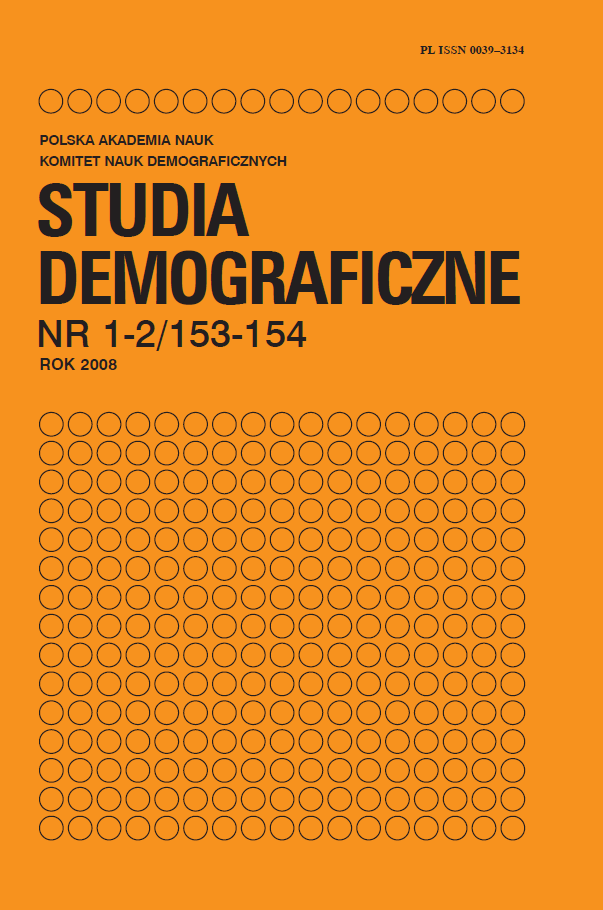Próba symulacji liczby aborcji w Polsce na podstawie danych w wybranych krajach europejskich
Main Article Content
Abstract
The 1993 Act on Family Planning, Human Fetus Protection and Conditions for Permissibility of Pregnancy Termination is one of the most restrictive in Europe. Despite the fact that the number of abortions reported officially went down from over 123 thousand in 1987 to 1.2 thousand in 1993, when the restricted law came into force, the low figures reported for subsequent years (such as 339 abortions in 2006) are considered to depict only a marginal share of the real numbers. Existing estimates range from 10-15 thousand to 80-200 thousand illegally performed abortions per year.
The significant drop in the recorded number of deliberate pregnancy terminations, however, did not coincide with an increase in the number of births. On the contrary, fertility declined considerably to the lowest levels observed since the 1950s. An increasing knowledge on family planning and a better availability of contraception undoubtedly contributed to the downward tendency of induced abortions. However, a question about the actual numbers of abortions remains open. That issue is the main subject of this article. Herewith, an attempt to evaluate the possible numbers of abortions in Poland was undertaken using two approaches. Since the assumptions used can be seen as rather restrictive, the proposed procedures can be best described as simulations. The first approach simulates the number of abortions that would be reported if the legal situation prior to 1990 was restored, and the trends in abortion in Poland and the adjacent countries since 1960 would continue. The simulated figures indicate between 30 and 50 thousand abortions per year. The second approach refers also to a hypothetical situation of no restrictive abortion regulation in Poland and assumes the abortion rate in Poland similar to those found in Sweden, Norway, France, Great Britain, Slovakia and Czech Republic in 2006. Under these conditions, the actual number of abortions would be between 90 and 185 thousand annually.
Article Details
References
[2] Appleby E., 2004, 50 pytań i odpowiedzi o aborcji, Stowarzyszenie Kultury Chrześcijańskiej Piotra Skargi, Kraków.
[3] Council of Europe, 2003, Demographic Yearbook 2003, Country data, http://www.coe.int/t/e/social_ cohesion/population/demographic_year_book/2003_edition/04%20Country%20Data/Default. asp
[4] Giza-Poleszczuk A., 2006, Życie seksualne i antykoncepcja w dzisiejszej Polsce. Komentarz do wyników badania zrealizowanego dla firmy Janssen Cilag przez Millward Brown SMG/KRC, Warszawa. http://www.erodzina.com/index.php?id=53,1162,0,0,1,0 (data dostępu: 18.04.2009).
[5] Giza-Poleszczuk A., 2008, Re: dane dotyczące antykoncepcji w Polsce, [gizapol@interia.pl], wysłany 10 Marca 2008.
[6] Henshaw S.K., 1994, Recent trends in the legal status of induced abortion, „Journal of Public Health Policy”, No. 15/2: 165–172.
[7] Iglicka K., 1989, Bezpośrednie czynniki płodności, „Studia Demograficzne”, nr 3/97: 37–54.
[8] Jóźwiak J., Paradysz J., 1993, Demograficzny wymiar aborcji, „Studia Demograficzne”, nr 1/111: 31–41.
[9] Kowalska I., 1993, Problem aborcji na tle postaw i zachowań w zakresie regulacji urodzeń (Wyniki ankietowego badania przemian rodziny i wzorców dzietności), „Studia Demograficzne”, nr 1/111: 43–85.
[10] Kulczycki A., 2005, Abortion policy in postcommunist Europe: the conflict in Poland, „Population and Development Review”, No. 21/3: 471–505.
[11] Majdański K., Schooynas M., Kłys J., 2000, Arena bitwy o życie – Aktualna sytuacja demograficzna w świecie i w Polsce, Fundacja Pomoc Rodzinie, Łomianki.
[12] Nowicka W. (red.), 2000, Ustawa antyaborcyjna w Polsce, funkcjonowanie, skutki społeczne, postawy i zachowania. Raport, Federacja na rzecz Kobiet i Planowania Rodziny, Warszawa. http://www.federa.org.pl/publikacje/raporty/aborcja2000/index.htm (data dostępu: 18.04.2009).
[13] Okólski M., 1984, Zapobieganie i przerywanie ciąży w Polsce, „Studia Demograficzne”, nr 2/76: 45–74. Polskie Stowarzyszenie Obrońców Życia, 2009, Aborcja. Jaka jest skala podziemia aborcyjnego w Polsce?, http://pro-life.pl/index.php?a=faq_list (data dostępu: 18.04.2009).
[14] Rossier C., Pirus C., 2007, Estimating the number of abortions in France, 19762002, “Population”, No. 62 (1): 55–88.
[15] United Nations, 2000, Demographic Yearbook 2000, United Nations, New York. http://unstats.un.org/UNSD/Demographic/products/dyb/dyb2000/Table13.pdf (data dostępu: 18.04. 2009).
[16] United Nations, 2001, Abortion Policies: a Global Review. Volume II: Gabon to Norway, UN Population Division, New York.
[17] United Nations, 2003, Fertility, Contraception and Population Policies, ESA/P/WP.182 United Nations, New York.
[18] http://www.un.org/esa/population/publications/contraception2003/Web-final-text.PDF (data dostępu: 18.04.2009).
[19] United Nations, 2004a, Concluding Observations of the Human Rights Committee – Poland, CCPR/CO/82/POL, International covenant on civil and political rights, United Nations, http://www.unhchr.ch/tbs/doc.nsf/(Symbol)/CCPR.CO.82.POL.En?Opendocument (data dostępu: 18.04.2009).
[20] United Nations, 2004b, World Contraceptive Use 2003, United Nations Publications, New York. http://www.un.org/esa/population/publications/contraceptive2003/wcu2003.htm (data dostępu: 18.04.2009).
[21] United Nations, 2005, Demographic Yearbook 2005, United Nations, New York. http://unstats.un.org/UNSD/Demographic/products/dyb/dyb2005/Table13.pdf (data dostępu: 18.04.2009).
[22] World Health Organization, Regional Office for Europe, zasób internetowy, http://data.euro.who.int/hfadb/ (data dostępu: 18.04.2009).
[23] Yaukey D., 1985, Demography – the Study of Human Population, St. Martin’s Press, New York.
[24] Zielińska E., 1993, Problem dopuszczalności prawnej przerywania ciąży w Polsce na tle tendencji światowych, „Studia Demograficzne”, nr 1/ 111: 9-26.
Akty prawne:
[25] Dz.U. 1956 nr 12 poz. 61, Ustawa z dnia 27 kwietnia 1956 r. o warunkach dopuszczalności przerywania ciąży, http://isip.sejm.gov.pl/servlet/Search?todo=file&id=WDU19560120061&type=2&name=D19560061.pdf ostatnio odwiedzona 18 kwiecień 2009.
[26] Dz.U. 1990 nr 29, poz. 178, Rozporządzenie Ministra Zdrowia i Opieki Społecznej z dnia 30 kwietnia 1990 r. w sprawie kwalifikacji zawodowych, jakie powinni posiadać lekarze dokonujący zabiegu przerywania ciąży, oraz trybu wydawania orzeczeń lekarskich o dopuszczalności dokonania takiego zabiegu.
[27] http://isip.sejm.gov.pl/servlet/Search?todo=file&id=WDU19900290178&type=2&name=D19900178.pdf ostatnio odwiedzona 18 kwiecień 2009.
[28] Dz.U. 1993 nr 17 poz. 78, Ustawa z dnia 7 stycznia 1993 r. o planowaniu rodziny, ochronie płodu ludzkiego i warunkach dopuszczalności przerywania ciąży.
[29] http://isip.sejm.gov.pl/servlet/Search?todo=file&id=WDU19930170078&type=3&name=D19930078Lj.pdf ostatnio odwiedzona 18 kwiecień 2009.
[30] Dz.U. 1996 nr 139 poz. 646, Ustawa z dnia 30 sierpnia 1996 r. o zmianie ustawy o planowaniu rodziny, ochronie płodu ludzkiego i warunkach dopuszczalności przerywania ciąży oraz o zmianie niektórych innych ustaw.
[31] http://isip.sejm.gov.pl/servlet/Search?todo=file&id=WDU19961390646&type=1&name=D19960646L.pdf ostatnio odwiedzona 18 kwiecień 2009.
[32] Dz.U. 1997 nr 157, poz. 1040, Obwieszczenie Prezesa Trybunału Konstytucyjnego z dnia 18 grudnia 1997 roku http://isip.sejm.gov.pl/servlet/Search?todo=file&id=WDU19971571040&type=1&name=D19971040L.pdf ostatnio odwiedzona 18 kwiecień 2009.
